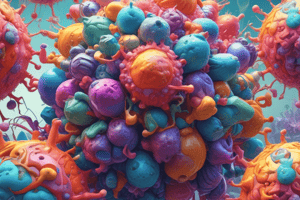Podcast
Questions and Answers
What is the primary limitation of the Tzanck smear test in diagnosing HSV or VZV?
What is the primary limitation of the Tzanck smear test in diagnosing HSV or VZV?
- High cost and labor-intensive process
- Inability to distinguish between HSV and VZV
- Poor sensitivity and specificity (correct)
- Lack of specificity due to overlap with other diseases
What type of analysis can be used to detect the presence of specific viral proteins in tissue sections?
What type of analysis can be used to detect the presence of specific viral proteins in tissue sections?
- Electron Microscopy
- Immunohistochemistry (correct)
- Polymerase Chain Reaction
- Immunofluorescence
What is the term for the characteristic changes in cellular morphology caused by viral infections?
What is the term for the characteristic changes in cellular morphology caused by viral infections?
- Viral inclusion bodies
- Necrosis
- Cytopathic effect (correct)
- Apoptosis
What is the purpose of using tagged antibodies in immunohistochemistry?
What is the purpose of using tagged antibodies in immunohistochemistry?
What type of viral diagnostic method involves the amplification of viral nucleic acid sequences?
What type of viral diagnostic method involves the amplification of viral nucleic acid sequences?
What is the term for the accumulation of newly assembled virus particles in the cytoplasm or nucleus of infected cells?
What is the term for the accumulation of newly assembled virus particles in the cytoplasm or nucleus of infected cells?
What is the primary purpose of the TCID50 assay in viral quantification?
What is the primary purpose of the TCID50 assay in viral quantification?
What is the characteristic feature of owl's eye cells in CMV infection?
What is the characteristic feature of owl's eye cells in CMV infection?
What is the primary method used to detect viral infection in the TCID50 assay?
What is the primary method used to detect viral infection in the TCID50 assay?
What is the purpose of serial dilution in the TCID50 assay?
What is the purpose of serial dilution in the TCID50 assay?
What is the characteristic feature of Negri bodies in rabies virus infection?
What is the characteristic feature of Negri bodies in rabies virus infection?
What is the primary application of histopathology and cytopathology in viral diagnosis?
What is the primary application of histopathology and cytopathology in viral diagnosis?
What is a limitation of conventional viral culture?
What is a limitation of conventional viral culture?
What is the purpose of a phenol red indicator in cell culture medium?
What is the purpose of a phenol red indicator in cell culture medium?
What type of effect can viruses have on cultured cells?
What type of effect can viruses have on cultured cells?
What is a benefit of viral culture compared to other diagnostic techniques?
What is a benefit of viral culture compared to other diagnostic techniques?
What is the purpose of a shell vial assay?
What is the purpose of a shell vial assay?
What is the unit of measurement for quantifying viral growth?
What is the unit of measurement for quantifying viral growth?
Flashcards are hidden until you start studying
Study Notes
Viral Diagnosis
- Pap smear can detect HPV, showing koilocytic atypia
- Parvovirus B19 can be detected by enlarged nuclei of erythroid precursors in a peripheral blood smear
- HSV can be detected by Tzanck smear of a lesion scraping, showing multinucleated giant cells
Morphologic Changes
- Some viruses produce characteristic changes to cellular morphology
- Changes can be highly specific for viruses, while others may overlap with other diseases or infections
- Confirm etiology with a more specific test
Viral Inclusions
- Newly assembled virus particles can accumulate in the cytoplasm or nucleus
- Aggregates of viruses and viral proteins can be seen as viral inclusion bodies
Immunohistochemistry (IHC)
- Tagged antibodies specific to certain viral proteins can detect specific viruses in tissue sections
Viral Quantification
- TCID50 assay estimates the amount of infectious virus in a suspension
- Serial dilutions of virus are used to infect cell monolayers
- The dilution at which there is no virus in 50% of replicates is the TCID50
Histopathology and Cytopathology
- Techniques used to detect viral infection by examining stained cells (cytology) or tissue sections (histology)
- Detects viral infection by characteristic inclusions or cell morphology
Histologic Identification of Viruses
- CMV: owl's eye cells with nuclear and cytoplasmic inclusions
- Parvovirus B19: enlarged ground glass nuclei in fetal liver
- Adenovirus: smudge cells in lung tissue
- Rabies virus: Negri bodies in the cytoplasm of nerve cells
- HSV: multinucleation, margination, and molding
- JC virus: ground-glass intranuclear appearance in oligodendrocytes
Culture and Tissue-Based Diagnostic Techniques
- Conventional viral culture can identify live viruses in various specimen types
- Cell lines are used to grow and amplify viruses in the laboratory
- Procedure involves inoculating the specimen onto a cellular monolayer
- Factors in cell culture medium include buffered medium, salts, amino acids, glucose, and vitamins
Studying That Suits You
Use AI to generate personalized quizzes and flashcards to suit your learning preferences.




